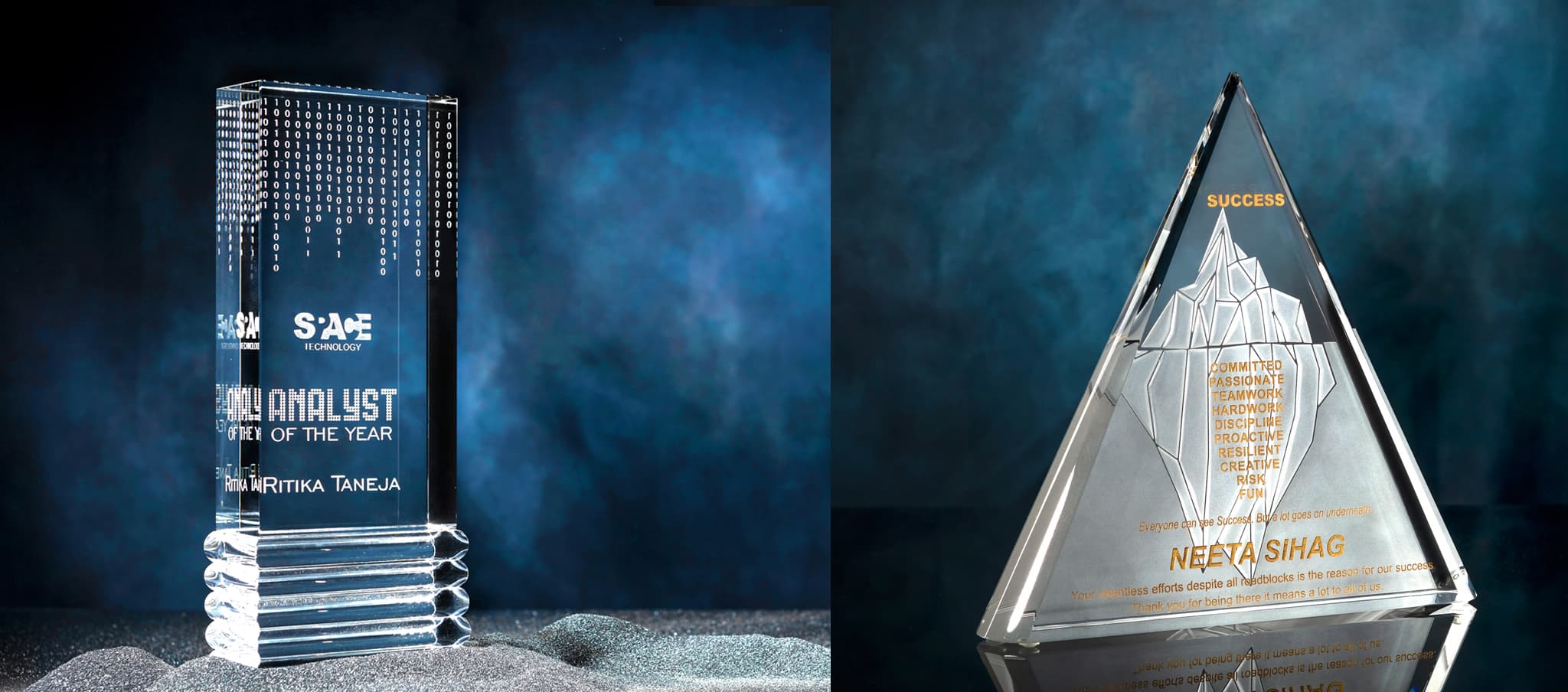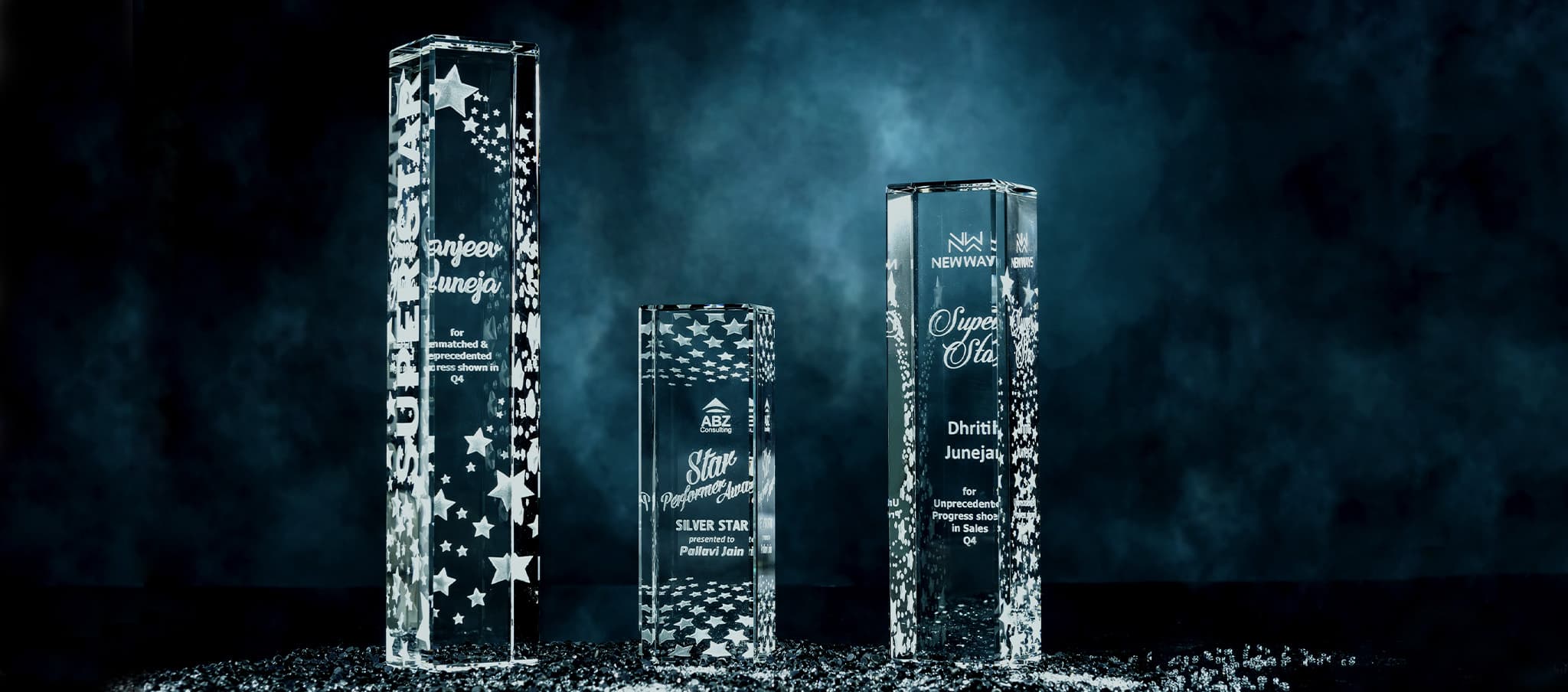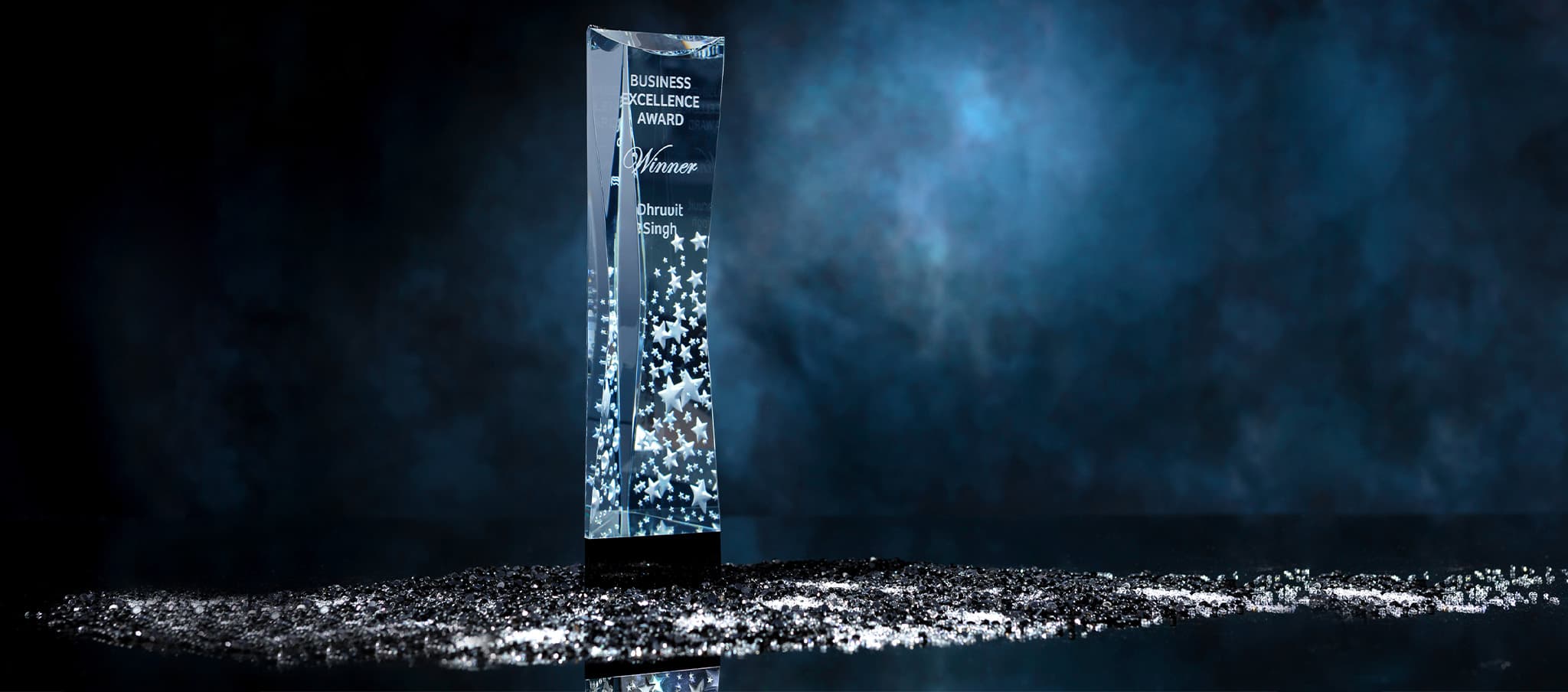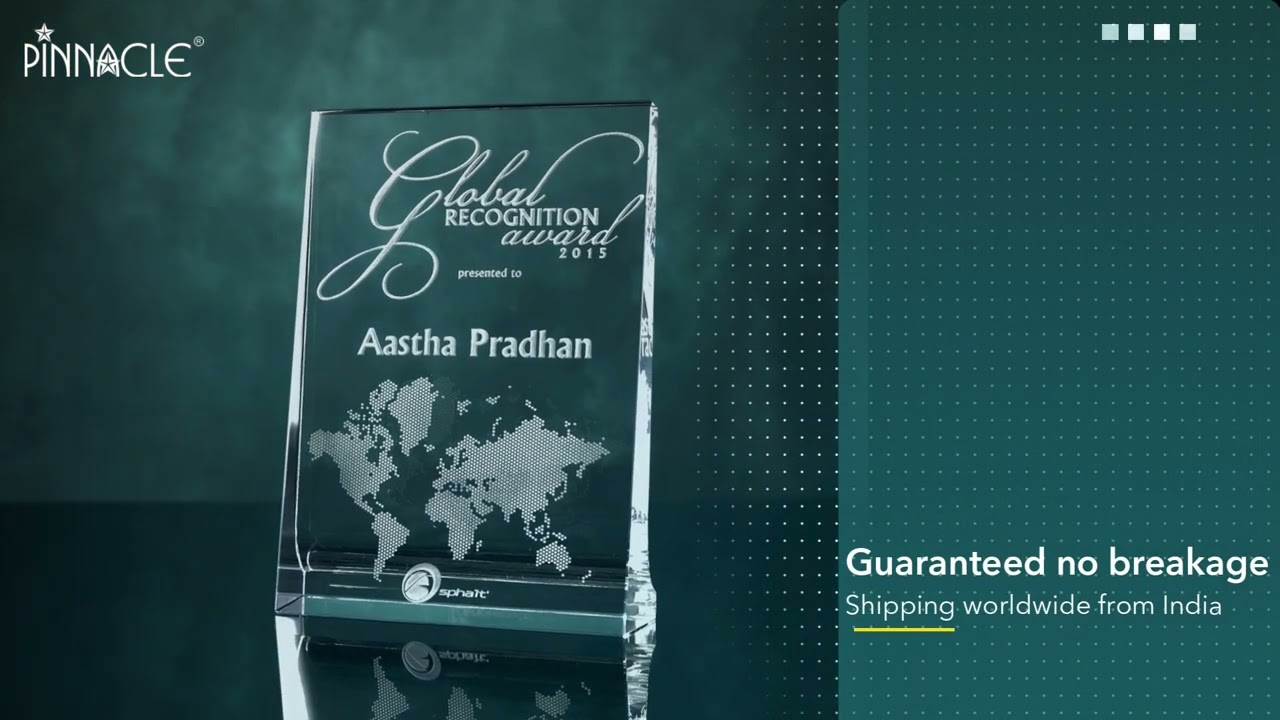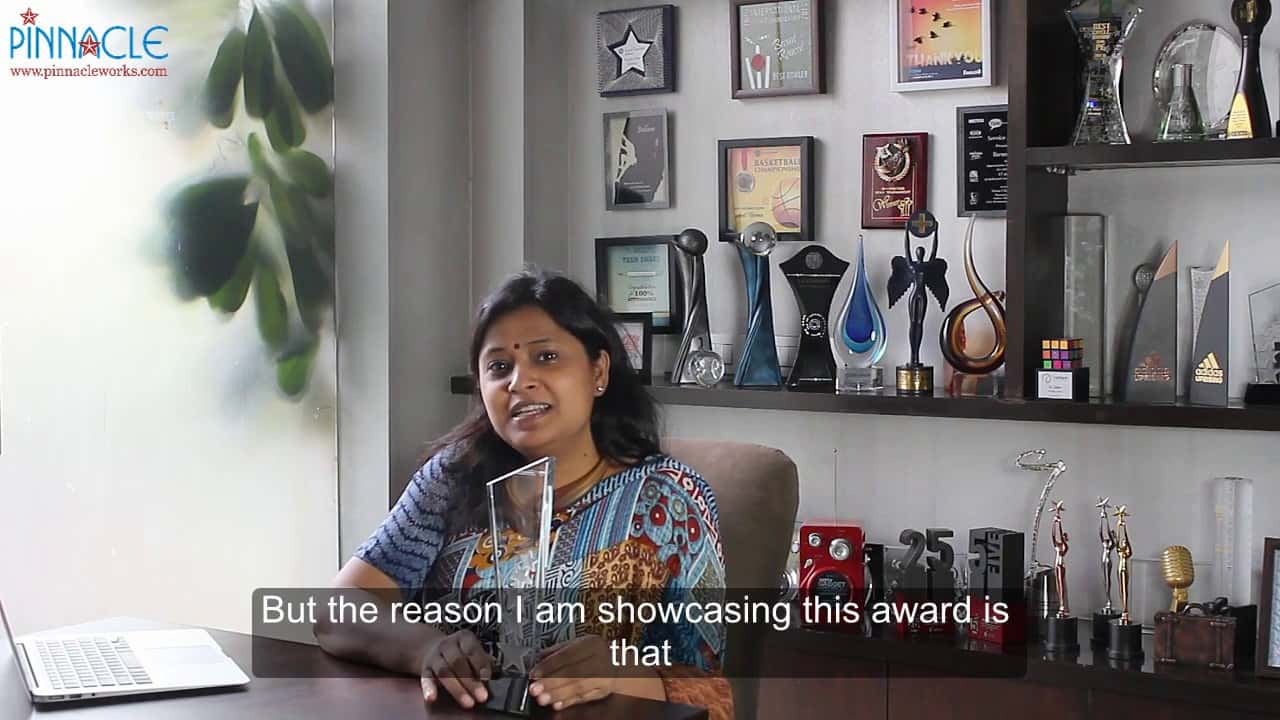Wow, time flies really fast.
In 2000 around the same time I was surfing online and found an ARA Show in America where different suppliers were showcasing products and machines to make awards and personalized gifts, that is when the idea of Pinnacle was born. To be more precious, makeitbuyit.com was born. (We changed the name to Pinnacle in 2002)
Though we started with personalized gifts in mind (and so the name makeitbuyit.com). Then I discovered awards and trophies market by accident…& loved every part of it …. rest is all history.
Found this article which I had written way back in 2002 for at that time Crystal Awards and Glass Awards were unheard of in India.
Everyone just made Trophies just with wood, silver, and metal.
We had to sell the concept and explain why crystal or glass before recommending a trophy which is not made of brass and precious metal like silver.
At Pinnacle we were the first in India to produce really good quality Glass Trophies, imported our own crystal awards and personalize them for our customers.
Something that we still continue till date is to introduce new concepts and ideas in the Rewards and Recognition space… of which over time many have become de facto standards in the recognition industry…
New Age Materials for Award – Glass, Crystal, and Granite.
Glass, Granite, and Crystal the new age materials for awards and recognition. They are fast replacing the more traditionally used material such as metal, wood, and acrylic across the world.
Reasons are many, though the key driving forces are these materials are:
- Maintenance Free – Crystal Awards & Glass Awards look elegant and different types of artwork can be engraved on it with ease.
- Trophies made from glass & crystal have the same sparkle and sheen even after ten years of the award ceremony.
- There is no need for re-polishing or buffing or making an acrylic case to save it from corroding.
- These are relatively new material for the award industry.
A brief into the technical details will help you make a more informed decision. A wrong choice and you could end up paying far more, or the final product will be dramatically different from what you expected it to be.
What is Crystal?

Today, anything that appears white in a glass is tagged as a crystal. This is why you see a range from Rs. 100 to Rs. 50,000 and all are tagged as crystal. This can be quite confusing. One is not sure if there are different types of crystal or they are paying for the brand name.
Honestly, both could probably be crystal, differing in the manufacturing process, ingredients or overall quality. But remember just because the word crystal is attached to the object, it does not make it expensive.
There are over 250 different varieties of crystal available today.
They all have their own specific application from drinking glass, to decorative masterpieces, and even in scientific laboratories. In the award industry, largely various grades of optic crystal and lead crystal are used. So we will restrict our article to these two varieties of crystals only.
Is Crystal a natural stone or man made material?
Contrary to popular belief crystal is a man-made material.
As I mentioned there are over 250 or more formulas to create crystal glass. Which formulae is used, is determined by the final application; whether it is for the drinkware industry or decorative pieces or scientific application or imitation jewellery.
However, there is one variety of crystal, called Sphatic, which is definitely natural and a precious stone. It is usually found in small pieces so it is used more as a precious stone for jewellery or to make small idols.
What is Optic Crystal?

Optic Crystal is relatively a new term for awards and recognition industry in India but worldwide for the finest awards and trophies optic crystal is the material to use.
It has the highest clarity and refractive index in the entire crystal family. This, however, does not have any lead content in it. Optic crystal is a hard substance which makes it a great surface for engraving.
Even fine details come out very clearly and distinctly on this material. It comes in rectangular blocks of different thickness from which various designs are cut. Optic crystals do not come in molten form, so molded or carved form of the optic crystal is not possible.
Optic crystals also come in different quality grades. This can make a tremendous difference in your budget.
Choose a wrong optic crystal quality; you either end up paying more or within a couple of months you will see your piece turning yellow.
Following are some checkpoints which may come in handy while selecting your award piece:
- When an optic crystal piece is presented to you, see it against bright light. You should not be able to see any waves or fine lines running inside the piece.
- The piece should have no tinge of yellow color whatsoever.
- A pure optic crystal piece is bright and sparks like a diamond.
- Take the piece and put it an angle so that you can see your tube light in the optic crystal piece. If the tube light gives a wavy image that means the surface is not perfectly polished. If the surface is polished to perfection than the tube light will appear absolutely straight and clear.
What is lead crystal?

Simply put, lead crystal is a form of crystal attainted by adding lead. That is how the term lead crystal is also derived.
Lead makes glass much softer, brighter (higher refractive index) and increases its clarity. So higher the lead content, higher the clarity and refraction will be. Lead crystal is largely used in the drinkware industry.
However, there is a growing concern about the safety of lead crystal crockery. Well, that’s another story…
Lead crystal comes in molten form only which can be molded into any desired shape. A lower grade of lead crystal will have lots of bubbles and lines which one can see when you hold it up against the light.
As you step up in quality the bubbles seem to disappear and you may or may not see the fine lines inside the crystal piece. There are very few companies that manufacture flawless lead crystal trophies and award. They come at a price which is worth paying.
To make things clear while a lead crystal glass can be used to make a lady figure using appropriate dyes. The optic crystal which comes in rectangular thick blocks can mostly be cut in straight lines to form any award shape.
What is white glass or extra clear glass?

Sometimes people refer to this variety of float glass as ‘Crystal Clear Glass’ or ‘Crystal Glass’. Though this is a not crystal by any standard.
Actually, the regular glass or green glass which you see most commonly has a sea green sheen. White glass which is mostly imported in India has an extremely faint sheen of blue, almost closer to being white so it is called white glass or extra clear glass but to call it crystal would be wrong.
This glass is not very common in India. It is not used in the regular construction business.
Awards and trophies especially come out brilliant in the white glass as compared to green glass. Especially the etched areas on white glass have a kind of shine in them. This glass comes only in sheet format of different thickness, starting from 4 mm up to 19 mm. This glass will always be more expensive than green glass or regular glass.
If you have the budget or can stretch it a bit, it will be worth going in for a white or extra clear glass.
What is coloured glass?

Sheets of glass also come in various colours such as blue, black, grey, red etc.
These are largely imported for a specific purpose and thus supply can be irregular for some of the colors. If you choose a coloured glass, as a part of your award or trophy double check for availability of the colors. Also, there can be variation in coloured glass.
What is Green Glass or Jade Glass?
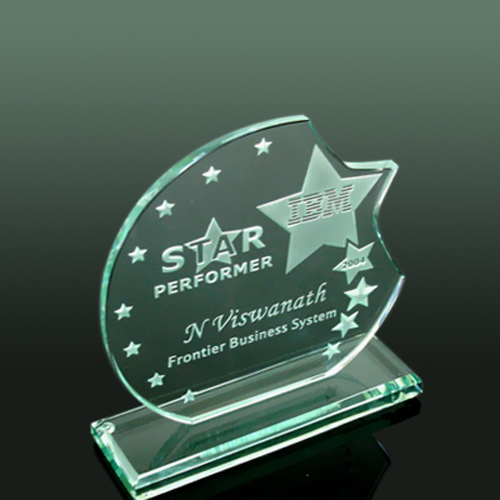
This is the most regular float or sheet glass which you will find all around you. It is called green or jade glass for it has a tinge of green in it.
This comes in various thickness and used for making trophies and awards. It is difficult to choose a poor quality of green glass for all manufacturers to maintain the same quality.
Though in a glass trophy you do not pay so much for the glass as much as you pay for the workmanship. Making a perfectly cut small piece with beveling and 90-degree flat bottom is not everybody’s cup of tea. All this is done manually and thus needs skilled hands to give the perfect finish which will turn an ordinary glass into a perfect piece of honor.
An important point to check is sticking between two pieces of glass. There should be no bubble or untidiness at the joint. It should be absolutely flawless joint.
Actually, a special UV curing glue is required to attain this clarity which is quite expensive. Ensure that your supplier uses only this glue for sticking.
Can different shapes be cut from Granite?

Pyramids of various forms and shapes in granite are fast becoming popular across the world. Granite is a very hard substance to cut and thus awards and trophies of granite do become more expensive than using a simple glass base.
Polishing small pieces of granite requires special tools and skills but once polished they come out quite perfect. The key point to see in granite is that the basic shapes are perfectly cut. Since it is a very hard substance this is difficult to attain.
Hope this helps you to make an informed choice next time when you buy trophies and awards. I would like to hear any questions or comments that you may have.


